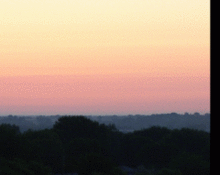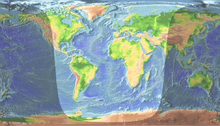Sunrise





Sunrise, also called sunup in some American English dialects, is the time at which the first part of the Sun appears above the horizon in the east. Sunrise should not be confused with dawn, which is the (variously defined) point at which the sky begins to lighten, some time before the sun itself appears, ending twilight. Because atmospheric refraction causes the sun to be seen while it is still below the horizon, both sunrise and sunset are, from one point of view, optical illusions.
The apparent westward revolution of Sun around the earth after rising out of the horizon is due to the Earth's eastward rotation. This illusion is so convincing that most cultures had mythologies and religions built around the geocentric model. This same effect can be seen with near-polar satellites as well.
As sunrise and sunset are calculated from the leading and trailing edges of the Sun, and not the center; this slightly increases the duration of "day" relative to "night." The sunrise equation, however, is based on the center of the sun.
In the Northern Hemisphere, the latest sunrise is not at the winter solstice around December 21, but rather in early January. Likewise, the earliest sunrise is not around June 21 (the summer solstice), but in early July. For one or two weeks surrounding both solstices, both sunrise and sunset get slightly later each day. Even on the equator, sunrise and sunset shift several minutes back and forth through the year, along with solar noon. This effect is plotted by an analemma.
Due to Earth's axial tilt, whenever and wherever sunrise occurs, it is always in the northeast quadrant from the March equinox to the September equinox and in the southeast quadrant from the September equinox to the March equinox.
The colors of the sky, throughout the day and at sunrise and sunset, are explained by the phenomena of both Rayleigh Scattering and Mie Scattering. The red hues of the sky at sunset and sunrise are caused by Mie Scattering, not Rayleigh Scattering. The hues of blue, violet, and green in the sky are due to Rayleigh Scattering. Rayleigh Scattering is scattering of shorter wavelength light, (e.g. blue & violet), by air atoms and molecules, (not statistical variations in density of the Earth's atmosphere). The magnitude or strength of Rayleigh Scattering varies by the reciprocal of the wavelength raised to the fourth power, and hence, does not explain the beautiful variations of reds, purples, oranges, and peachy colors. The latter colors arise from Mie Scattering, low angle scattering of light off of dust, soot, smoke, and (ash), particles. Mie Scattering, (producing the colors of sunset and sunrise), is beautifully recognizable down-wind of and after dust storms, forest fires, and volcanic eruptions that inject large quantities of fine particulate matter into the atmosphere. A number of eruptions in recent times, such as those of Mount Pinatubo in 1991 and Krakatoa in 1883, have been sufficiently large to produce remarkable sunsets and sunrises all over the world. Sometimes just before sunrise or after sunset a green flash can be seen.
Sunsight is a term, according to Allegra Fuller Snyder, collectively coined by Buckminster Fuller's family and used to express the first sighting of the sun in the morning. As the sun actually neither rises nor sets, the terms "sunrise" and "sunset" were anathema to Fuller. The term used to replace sunset is "sunclipse."
Sunrise is a symbol in art and literature of new hope and new beginnings.
See also
External links
- Sunrise and sunset calculator
- Sun or Moon Rise/Set Table for one Year
- US Navy Sunrise and Sunset calculator
- Full physical explanation of sky color, in simple terms
- An Excel workbook with VBA functions for sunrise, sunset, solar noon, twilight (dawn and dusk), and solar position (azimuth and elevation); by Greg Pelletier, translated from NOAA's online calculators for solar position and sunrise/sunset
- sun.exnatura.org Online sunrise/-set calendar with interactive location finder
